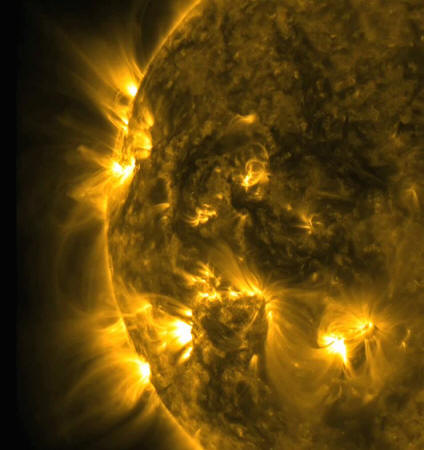|
by Bjorn Carey
Stanford Report from Stanford Website
The effects of the event, which occurs
every 11 years, will ripple throughout the solar system and be
closely monitored by Stanford solar physicists.
Video by Kurt Hickman
The effects of the
event will be closely monitored by Stanford solar physicists.
The magnetic field gradually reduces toward zero, and then rebounds with the opposite polarity.
The effects of this event are widespread:
The sun is also typically
at the peak of its activity during a magnetic field reversal, which,
in addition to an increased number of sunspots, is marked by a surge
in solar flares and coronal mass ejections.
Earth's magnetic field can also affect major electronic systems, Hoeksema said, such as power distribution grids and GPS satellites, so scientists are keen to monitor the heliosphere.
Because Wilcox has been operating for so long and with minimal changes to its detecting devices, it has produced one of the most complete and detailed records of daily changes to the sun's global magnetic field.
An interesting feature of the current transition, Hoeksema said, is that the sun's hemispheres are changing at
different rates. The northern hemisphere flipped this summer; the
southern hemisphere should flip in the near future.
This indicated that the upcoming solar cycle would be weak as well, which is being borne out in current measurements.
-
What It Means -
in the next three to four
months, scientists say.
of hot plasma from the sun's
surface.
if magnetic forces draw out loops and strands
of hot plasma
from the sun's surface.
The sun's magnetic field, which spans the solar system, is just months away from flipping, observatory measurements show.
Hoeksema is the director of Stanford's Wilcox Solar Observatory, one of just a few observatories around the world that monitors the sun's polar magnetic fields.
The sun's magnetic field changes polarity approximately every 11 years during the peak of each solar cycle as the sun's inner dynamo reorganizes itself. This next reversal - which will be only the fourth observed since tracking began in 1976 - will mark the midpoint of Solar Cycle 24.
During a magnetic field reversal,
Scientists are already seeing signs of the reversal happening, and this time there's a twist:
That means that for now, at least, the sun effectively has two South Poles.
Soon both poles should be completely reversed.
The Wilcox Solar Observatory has been observing the sun's magnetic field since 1975, and its scientists have been converting those numerical measurements into a map that can now be viewed online.
What Does a Reversal Mean?
A reversal of the sun's magnetic field will have consequences throughout the solar system since the domain of the sun's magnetic influence - called the heliosphere - extends far beyond Pluto.
Changes to the field's polarity ripple all the way out to the Voyager probes, which are racing toward interstellar space.
Playing a central role in solar field reversals is the "current sheet," a sprawling surface that juts out of the sun's equator where the sun's slowly rotating magnetic field induces an electric current.
The current itself is small - only one ten-billionth of an amp per square meter - but there's a lot of it, and the entire heliosphere is organized around it. During field reversals, the current sheet becomes very wavy. Scherrer likens the undulations to the seams on a baseball.
As the Earth orbits the sun, our planet dips in and out of the wavy current sheet, and the transitions can stir up stormy space weather around us.
The geometry of the current sheet can also affect Earth's exposure to cosmic rays, which are high-energy particles accelerated to the speed of light by supernova explosions and other violent events in the galaxy.
Cosmic rays pose a threat to astronauts and space probes, and some researchers say they might also affect the cloudiness and climate of Earth.
The sun's current sheet functions as a barrier to cosmic rays, preventing them from penetrating into the inner solar system. And a wavy, crinkly current sheet appears to create a better shield against these energetic particles.
Earth's Flip-Flop Coming
The sun isn't the only body in the solar system with a magnetic field that reverses.
Earth has a magnetic field as well, and it has flipped many times over the last billion years.
This isn't surprising, Scherrer said, because the magnetic fields of both the sun and the Earth are thought to be generated by similar "dynamo" processes that involve rotating and convecting electrically conducting fluids - molten iron in the case of the Earth and hot, ionized gases for the sun.
The difference, however, is that Earth's magnetic field reversals happen much less frequently - only once every 200,000 to 300,000 years on average, although the actual time can vary widely - and over much longer timescales.
An analysis of centuries-old ship logs performed in 2006, for example, found that the Earth's magnetic field weakens in staggered steps, and that its strength has declined by a few percentage points since 1840.
If this decline is continuous, scientists predict the Earth's magnetic field could reverse sometime in the next 2,000 years.
When it does happen, Scherrer thinks that the flip will happen gradually - as is the case with the sun - and won't be marked by any kind of calamitous drop of the Earth's magnetic field strength to zero.
|

